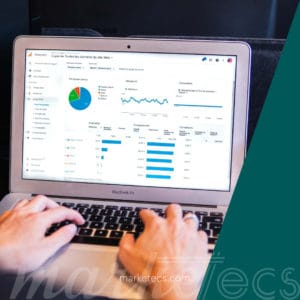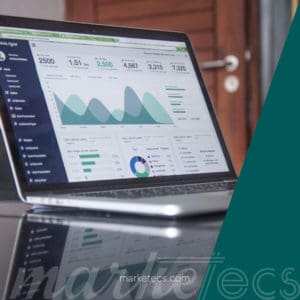Overview:
- Where to Find Email Marketing Data
- How to Find Social Media Data
- Where to Find Website Analytics
- How to Find Advertising Analytics
- Marketing Dashboards
- Google Data Studio
You’ve made a marketing plan, drafted the content and are now implementing it.
Don’t sit back yet. There’s more work to do.
To get a full glimpse into the potential effectiveness and to best leverage your marketing plan results, you need to nerd out on the proactive and reactive data…
But how do you do that? Where to even look?
Let’s take a look at each marketing channel program and platform individually and where to find both proactive and reactive data.
How to Analyze Email Marketing Data

Being proactive in email marketing is often tied to industry statistics, keyword research, and lead magnet selection.
For starters, it helps to know what the average in your industry is for open and click rates. Here’s a resource we found for email stats by industry.
Compare your click rates to a similar industry as yours. How does it match up? Now you have realistic measures for success.
Building your own list and acquire subscribers is typically achieved through a lead magnet or opt-in process. Here again, content is king, so you will want to do your keyword research in order to attract your ideal clients.
This process is part of your sales funnel, so the topic, content, and delivery should be identified via the ideal client process and keyword research using platforms such as SEMRush, Uber Suggest, Google Trends, and Buzz Sumo.
Low email click rates could be a reflection of misaligned copy, or a misaligned target.
Once you have your email marketing plan in operation, it’s time to watch the reactive data. Email marketing platforms will give you the data you need to analyze your subscriber acquisition rates, as well as broadcasts and automated campaigns for open rates and click through rates.
There’s plenty of power in email marketing, so much so that 4 out of 5 marketers say they’d give up social media rather than email marketing. Additionally, marketers who use segmented campaigns benefit from as much as a 760% revenue increase.
Check out the powerful data on email marketing at: https://blog.hubspot.com/marketing/email-marketing-stats
Social Media Marketing Data: A Smart Approach
Proactive social media content data can be tricky.
Social media trends shift quickly, so programs that show you trends could be misleading for longer-term success.
Because of this, we find it best to keep social media a sharing platform and offer:
- conversational, offering updates into what’s trending for your business
- behind the scenes notes and views
- industry news – a great way to share frequent updates
We pair this with planning to support your sales funnel and all the efforts around your content marketing plan.
In this way, your social media becomes an interesting mixture with a message.
For social media data, we suggest focusing your efforts on specific platforms.
For example:
- according to Statista, 64% of Instagram users are under the age of 34
- a majority of U.S. TikTok users are between the ages of 10 and 19.
If your ideal client is in their 50s for example, you may not focus as much attention on Instagram or TikTok.
To explore some useful social media statistics regarding this, visit this great article from Hubspot.
Once posting on social media has become consistent, all the social media platforms offer ways to view stats on:
- followers
- subscribers
- post engagement
- plus, advertising results
These data points offer insights into the types of content or media you may want to focus more effort on.
Here are links to find analytics on each of the major social media platforms:
- Facebook – https://business.facebook.com/latest/insights/overview
- Instagram – https://blog.hubspot.com/marketing/how-to-use-instagram-insights
- LinkedIn – https://www.linkedin.com/me/search-appearances/ or https://www.linkedin.com/sales/ssi
- YouTube – https://support.google.com/youtube/answer/9002587?hl=en
- Twitter – https://analytics.twitter.com/accounts
Website Analytics Offer Valuable Insights
 Being proactive in your website analytics revolves around knowing your ideal client and the keywords and phrases that will drive them to your website.
Being proactive in your website analytics revolves around knowing your ideal client and the keywords and phrases that will drive them to your website.
Once drawn to your website, the offers, information, and presentation will encourage them to take action. As mentioned before, this is all part of your sales funnel and keyword research.
When your website is up and running, collecting its own traffic and data, Google offers a service to review and track website metrics. This service is available at both a base level and a very detailed level with topics such as “goals” and “behaviors” via Google Analytics.
This reactive website data is very valuable because it will give you insights into which platforms are driving traffic to your site and deserve your efforts, as well as which pages or content get the most results.
Make Informed Decisions with Advertising Analytics
Before you start an advertising campaign, it’s possible – and recommended- to gain some insight into what your expectations and goals should be.
Programs such as Uber Suggest can give you CPC estimates for keywords. Google Search console can help you identify search volume.
Then you can pair this information with the data you already have on your ideal client, website traffic, and social media demographics to help you decide on which platform to advertise and what a realistic budget should be.
Once you’ve chosen to run an advertising or PPC campaign, there’s a dashboard within the platform you’re advertising with where you can review your advertising results and statistics.
These results can help you determine where to make changes in:
- Budget
- Audience targeting
- Copy, content or wording
- Creative, images or video
We often recommend a ‘testing’ period with advertising. This is where you would utilize a variety of content at a lower ad spend in order to collect data and then determine the best course of action for a larger budget.
All marketing platforms and the data they produce interact with each other to help you make informed decisions about your marketing efforts. And while all of these data collection options are effective and useful, this process of checking every platform manually feels like a lot of work. It can be!
Make Life Easier With Marketing Dashboards
 In today’s world of digital marketing, most people want a way to see and analyze as much data as possible in a single view. This is because many efforts are -or should be- supporting each other, especially if you’re running a launch campaign or are focused on omnichannel marketing.
In today’s world of digital marketing, most people want a way to see and analyze as much data as possible in a single view. This is because many efforts are -or should be- supporting each other, especially if you’re running a launch campaign or are focused on omnichannel marketing.
There are several SasS marketing dashboard programs in which you can invest. They will collect and coagulate data and send you an automated report at a particular frequency.
Finding a dashboard program that will work for you is based on making a list of all the marketing platforms that you need to pull from and confirming the dashboard program in question can sync and integrate with all of your needs.
Typically, these marketing dashboard programs allow you to connect all of your marketing channels and then help you to create a meaningful report that can be automated and sent right to your email on a regular basis.
We have often used a program called Whatagraph to collect and monitor results across multiple platforms. We have also invested in other such tools via AppSumo – which is a great way to access new tools at a reasonable cost for testing purposes.
Get to Know Google Data Studio
Google Data Studio, with tag manager, is an example of a free option that you can build and customize yourself. This option requires a savvier set-up, but the flexibility could be the answer to getting exactly what you want in a reporting dashboard.
Here’s a list of all the data collection options available in Google Data Studio: https://datastudio.google.com/data
Here’s an introduction to Google Data Studio: https://support.google.com/datastudio/answer/6283323?hl=en
Take a step at a time.
At the end of the day, it doesn’t need to be fancy. It’s just important that you identify your metrics in a way that you can easily monitor the important data. And then make sure that data can easily get into the hands of the key people that need it!
Not into figuring out the often-complex ins & outs of marketing analytics? With our digital marketing expertise, we’ll help you figure it all out. Click here to set up a time to chat.



